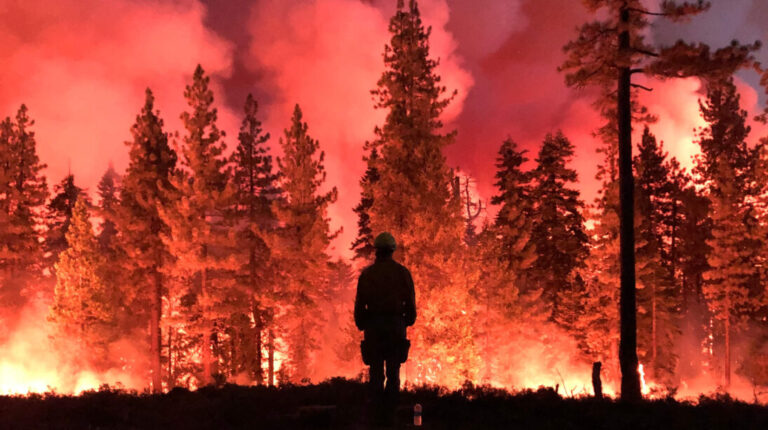Photo: Night operations on the Caldor Fire in September, 2021. Acacia England/USFS
The administration’s plan to thin forests ignores an important way that wildfires spread and set houses aflame.
On Maui, a solitary beachfront home, unscorched by the wildfire that devastated the town of Lahaina in August, stands amid the ashes of dozens of incinerated homes. And in Northern California, a large, mostly unscathed forest mysteriously surrounds the devastated town of Paradise, lost five years ago to another wildfire.
These puzzling scenes illustrate a difficult truth about wildfires. Many structures in these towns were destroyed by firebrands — hot burning embers that can be carried by strong winds over many miles — not by flames from the original fires. Nearly 200 people perished in the Lahaina and Paradise fires combined. Several other communities in the American West have been lost this same way.
The scenes also point to an obvious way to protect people from wildfire. The Lahaina home was recently remodeled, which unintentionally hardened the structure — making it resilient to fire.
Wildfires are a yearly threat to anyone living near a forest, grassland, or chaparral, which includes about half of all U.S. addresses. President Joe Biden’s administration has introduced an ambitious 10-year, $50 billion plan it claims will protect those homes, to be funded partly with taxpayer dollars and other sources yet to be determined. The administration’s plan focuses on a massive increase in logging across the country in order to reduce fuels in bone-dry forests. Very little will likely be spent on making homes near forests more fire resilient. But the fires in Paradise and Maui show that the administration is on the wrong course.
Reducing fuels usually means thinning, or partially logging, a forest, and later setting it on fire in a controlled burn. This strategy may make a fire less likely to spread but won’t always protect the public from one, according to John Winn, a U.S. Forest Service press officer. “There are no absolute guarantees,” he told us in an email, “particularly under extreme weather and fuel conditions.”
Disturbingly, the Forest Service is not informing the public about this concern. We reviewed several documents explaining the agency’s wildfire strategy to the public, which point to tree-cutting, usually followed by prescribed burns, as the way to reduce the risk that an ignition “could expose homes, communities, and infrastructure to wildfire.” The tone is uniformly upbeat and positive. There’s no mention of the harrowing firebrand threat and little to no information about how people can harden their homes — their only proven defense against them.
What’s more, the Forest Service often exaggerates the benefits of cutting down trees to prevent fire. For example, one of the agency’s informational videos gives sole credit to a forest treatment project, which included tree thinning and controlled burns, for slowing down the massive Caldor wildfire in 2021 and saving “businesses, homes, and lives” in the resort city of South Lake Tahoe, California. However, daily incident reports filed by fire supervisors on the front lines and media reports suggest something else was responsible for […]
Full article: undark.org

